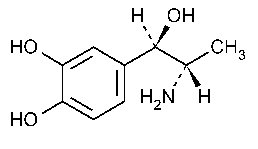Levonordefrin
1,2-Benzenediol,4-(2-amino-1-hydroxypropyl)-,[R-(R*,S*)]-.
(-)-a-(1-Aminoethyl)-3,4-dihydroxybenzyl alcohol [18829-78-2;829-74-3].
»Levonordefrin,dried in vacuum at 60 for 15hours,contains not less than 98.0percent and not more than 102.0percent of C9H13NO3.
for 15hours,contains not less than 98.0percent and not more than 102.0percent of C9H13NO3.
Packaging and storage—
Preserve in well-closed containers.
Identification—
A:
Infrared Absorption á197Kñ.
Solution:
25µg per mL.
Medium:
0.1Nhydrochloric acid.
Specific rotation á781Sñ:
between -28 and -31
and -31 .
.
Test solution:
50mg,previously dried,per mL,in 0.3Nhydrochloric acid.
Loss on drying á731ñ—
Dry it in vacuum at 60 for 15hours:it loses not more than 1.0%of its weight.
for 15hours:it loses not more than 1.0%of its weight.
Residue on ignition á281ñ:
not more than 0.2%.
Chromatographic purity—
Standard solutions—
Dissolve an accurately weighed quantity of USP Levonordefrin RSin a mixture of methanol and glacial acetic acid (96:4)to obtain a Standard stock solution having a known concentration of 5mg per mL.Dilute this solution quantitatively with a mixture of methanol and glacial acetic acid (96:4)to obtain Standard solutions,designated below by letter,having the following compositions:
| Standard solution | Dilution | Concentration (µg RSper mL) |
Percentage (%, for comparison with test specimen) |
| A | (1in 10) | 500 | 1.0 |
| B | (1in 20) | 250 | 0.5 |
| C | (1in 50) | 100 | 0.2 |
| D | (1in 100) | 50 | 0.1 |
Test solution—
Dissolve an accurately weighed quantity of Levonordefrin in a mixture of methanol and glacial acetic acid (96:4)to obtain a solution containing 50mg per mL.
Procedure—
Apply separately 5µLof the Test solutionand 5µLof each Standard solutionto a suitable thin-layer chromatographic plate (see Chromatography á621ñ)coated with 0.25-mm layer of chromatographic silica gel mixture.Position the plate in a chromatographic chamber,and develop the chromatograms in a solvent system consisting of a mixture of n-butyl alcohol,water,and glacial acetic acid (70:20:10)until the solvent front has moved about three-fourths of the length of the plate.Remove the plate from the developing chamber,mark the solvent front,and allow the solvent to evaporate in warm,circulating air.Examine the plate under short-wavelength UVlight.Expose the plate to iodine vapors,and examine again.Compare the intensities,observed by both visualizations,of any secondary spots observed in the chromatogram of the Test solutionwith those of the principal spots in the chromatograms of the Standard solutions:the sum of the intensities of secondary spots obtained from the Test solutioncorresponds to not more than 1.0%of related compounds,with no single impurity corresponding to more than 0.5%.
Assay—
Transfer about 350mg of Levonordefrin,previously dried and accurately weighed,to a small flask,dissolve in 50mLof glacial acetic acid,heating,if necessary,add 1drop of crystal violet TS,and titrate with 0.1Nperchloric acid VSto a green endpoint.Perform a blank determination,and make any necessary correction.Each mLof 0.1Nperchloric acid is equivalent to 18.32mg of C9H13NO3.
Auxiliary Information—
Staff Liaison:Andrzej Wilk,Ph.D.,Senior Scientific Associate
Expert Committee:(PA5)Pharmaceutical Analysis 5
USP28–NF23Page 1123
Phone Number:1-301-816-8305
